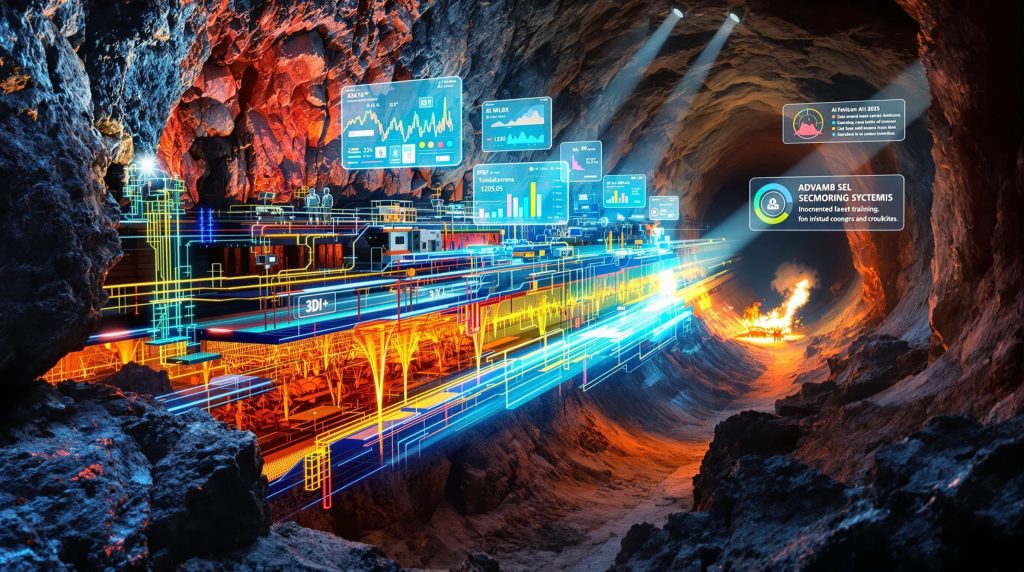How Do Seismic Events Impact Underground Mining Operations?
Underground mining operations face unique challenges when it comes to seismic activity. As mines extend deeper beneath the surface, the risk of seismic events increases significantly due to stress redistribution in the surrounding rock mass. These events can range from minor tremors to catastrophic rock bursts that threaten worker safety and operational continuity.
Seismic risks in underground mining stem from both natural tectonic activity and mining-induced seismicity. The latter occurs when excavation activities alter the stress state of the rock mass, potentially triggering sudden energy releases. Deep mines are particularly vulnerable as they operate under high stress conditions where even small disturbances can initiate significant seismic responses.
According to the Mine Safety and Health Administration (MSHA), seismic events in underground mines have been responsible for an average of 2-3 fatalities annually in the United States over the past decade. The International Labour Organization reports that mining-induced seismicity affects approximately 15% of all underground mining engineering worldwide, with incidents increasing by 23% as mining depths exceed 1,000 meters.
The consequences of underground seismic events include:
| Impact Type | Potential Consequences | Safety Implications |
|---|---|---|
| Direct Damage | Tunnel collapse, equipment destruction | Immediate threat to worker safety |
| Operational Disruption | Production delays, access restrictions | Economic losses, recovery costs |
| Long-term Stability | Compromised ground support systems | Increased maintenance requirements |
| Environmental Effects | Groundwater disruption, surface subsidence | Regulatory and community concerns |
Research published in the International Journal of Rock Mechanics and Mining Sciences indicates that mining-induced seismicity represents one of the most significant challenges facing deep underground operations, with consequences extending beyond immediate safety concerns to long-term operational viability.
Understanding these impacts is essential for developing effective risk reduction strategies that protect both personnel and mining assets.
Why Are Deep Mines More Susceptible to Seismic Activity?
The relationship between mining depth and seismic risk follows a clear pattern: as mines extend deeper, seismic hazards increase exponentially. This correlation stems from several fundamental geomechanical principles.
Research from the Colorado School of Mines demonstrates that seismic event frequency increases exponentially with depth, with mines operating below 1,500 meters experiencing 4-6 times more seismic events than those at 500-800 meters.
Increasing Stress Conditions with Depth
At greater depths, the weight of overlying rock creates immense pressure on remaining rock structures. According to studies published by the Canadian Institute of Mining, vertical stress increases at approximately 27 MPa per kilometer of depth, creating conditions where rock is already near its failure threshold before mining begins.
Stress Redistribution During Excavation
When tunnels and stopes are excavated, stress must redistribute around these openings. This redistribution creates zones of high stress concentration, particularly at excavation boundaries, corners, and pillars. In deep mines, even minor stress increases can push rock beyond its strength limits.
Geological Discontinuities
Deep mines often encounter complex geological structures including faults, shear zones, and dykes. These discontinuities create natural weaknesses in the rock mass that can become focal points for seismic activity when disturbed by mining operations.
Rock Mass Properties
Certain rock types exhibit brittle failure characteristics, storing elastic energy and releasing it suddenly when their strength is exceeded. Hard, brittle rock formations commonly found in deep mining environments are particularly prone to violent failure mechanisms.
The South African Council for Scientific and Industrial Research has documented that in hard rock mining environments, brittle failure mechanisms become dominant at depths exceeding 2,000 meters, where the ratio of unconfined compressive strength to in-situ stress drops below 0.3.
According to research published in Rock Mechanics and Rock Engineering, "the combination of high stress gradients and geological logging codes creates a complex failure environment where traditional support systems often prove inadequate."
The combination of these factors creates an environment where seismic events become increasingly probable and potentially more severe as mining progresses deeper, necessitating sophisticated monitoring and control strategies.
What Technologies Enable Effective Seismic Monitoring?
Modern seismic monitoring systems form the foundation of effective risk management in underground mines. These technologies provide critical data for understanding seismic patterns, identifying high-risk areas, and implementing timely interventions.
According to the International Society for Rock Mechanics, modern microseismic monitoring networks can detect events as small as magnitude -4.0, representing a 1000-fold improvement in sensitivity compared to systems from the 1990s.
Microseismic Monitoring Networks
Advanced microseismic monitoring networks utilize strategically placed geophones and accelerometers throughout the mine to detect and locate even minor seismic events. These systems typically include:
- High-sensitivity sensors capable of detecting events as small as magnitude -3.0
- Real-time data transmission infrastructure
- Automated processing algorithms for rapid event characterization
- 3D visualization capabilities for spatial analysis of seismic activity
The data collected through these networks enables mine operators to identify seismically active zones, track changes in activity patterns, and evaluate the effectiveness of risk mitigation measures.
Artificial Intelligence Applications
AI and machine learning technologies have revolutionized seismic risk assessment in underground mining. These systems can:
- Analyze patterns in historical seismic data to identify precursory signals
- Predict potential seismic responses to planned mining activities
- Automatically classify events based on their characteristics and potential hazard
- Optimize ground support systems based on observed seismic responses
Research from the University of Western Australia indicates that AI in drilling and blasting can process and classify up to 10,000 microseismic events per day with 95% accuracy, compared to 200-300 events processed manually by human analysts.
Leading mining companies are increasingly implementing AI-powered seismic forecasting tools that integrate geological, geotechnical, and production data to provide comprehensive risk assessments.
Ground Movement Monitoring
Complementary monitoring technologies track subtle ground movements that may precede significant seismic events:
- Laser-based convergence monitoring systems
- Extensometers and borehole deformation gauges
- Distributed fiber optic sensing systems that detect strain changes along tunnel walls
- Ground-penetrating radar for detecting hidden discontinuities
These technologies provide early warning indicators of increasing stress conditions, allowing for proactive intervention before critical thresholds are reached.
Studies published in Tunnelling and Underground Space Technology report that integration of multiple monitoring technologies provides comprehensive risk assessment capabilities that were previously impossible with single-sensor approaches.
How Can Controlled Blasting Reduce Seismic Risks?
Blasting practices significantly influence seismic response in underground mines. By implementing controlled blasting techniques, operators can minimize stress concentrations and reduce the likelihood of triggering damaging seismic events.
Research from the Colorado School of Mines demonstrates that optimized electronic detonation timing can reduce peak particle velocities by 30-45% compared to conventional millisecond delays.
Sequential Timing Strategies
Modern electronic detonation systems enable precise control over blast timing sequences. By carefully designing these sequences, blasting engineers can:
- Distribute energy release over longer time periods
- Reduce peak vibration levels
- Minimize stress wave interactions that could trigger seismic responses
- Create more uniform fragmentation patterns that avoid creating stress concentrations
Studies have shown that optimized timing sequences can reduce blast-induced vibrations by up to 40% compared to conventional approaches.
Perimeter Control Techniques
The boundary between excavated and intact rock represents a critical zone for stress concentration. Specialized perimeter control techniques help maintain rock mass integrity at these boundaries:
- Smooth blasting methods that use closely spaced, lightly charged perimeter holes
- Pre-splitting techniques that create controlled fracture planes before main production blasting
- Buffer blasting zones that provide gradual transitions between production blasts and final perimeters
According to the International Society of Explosives Engineers, smooth blasting techniques using perimeter holes spaced 0.3-0.5 meters apart with reduced charge weights can maintain excavation boundary integrity while reducing stress concentrations by up to 25%.
These techniques preserve rock mass strength at excavation boundaries, reducing the potential for stress-induced failures.
Vibration Monitoring and Feedback
Continuous improvement in blasting practices requires systematic monitoring and analysis:
- Blast vibration monitoring at key locations throughout the mine
- Post-blast seismic response analysis to identify correlations between blasting parameters and seismic activity
- Adaptive blast design protocols that incorporate feedback from monitoring data
Research published in the Journal of Mining Science indicates that systematic blast vibration monitoring and adaptive design protocols represent essential elements of seismic risk management in deep mining environments.
This monitoring-feedback loop enables progressive refinement of blasting practices to minimize seismic risks while maintaining production efficiency.
What Role Does Stress Management Play in Seismic Control?
Proactive stress management represents one of the most effective approaches to reducing seismic risks underground. By implementing techniques that control stress distribution and release energy gradually, operators can significantly reduce the potential for damaging seismic events.
Studies from the South African Institute of Mining and Metallurgy report that hydraulic fracturing preconditioning can reduce rock burst potential by 50-80% in high-stress mining areas.
Destressing Techniques
Several methods can be employed to deliberately release accumulated energy in controlled ways:
Hydraulic Fracturing
Hydraulic fracturing involves injecting fluid under high pressure into targeted rock zones to create controlled fractures. This technique:
- Relieves concentrated stresses in advance of mining
- Creates fracture networks that dissipate energy gradually
- Can reduce rock burst potential by up to 70% in high-stress areas
Large-Diameter Relief Holes
Strategic drilling of large-diameter (200-300mm) boreholes ahead of mining fronts provides stress relief by:
- Creating free surfaces that allow stress to redistribute gradually
- Providing space for rock expansion under pressure
- Establishing pathways for energy dissipation during minor seismic events
Research published in Rock Mechanics and Rock Engineering indicates that large-diameter relief holes (200-400mm diameter) drilled 20-50 meters ahead of mining faces can reduce peak stress concentrations by 15-35%.
Preconditioning Blasting
Carefully designed preconditioning blasts fracture the rock mass in advance of production mining:
- Creating distributed fracture networks that reduce rock brittleness
- Lowering the rock mass's ability to store elastic energy
- Establishing preferential failure planes that limit the magnitude of potential seismic events
Optimal Extraction Sequencing
The sequence in which ore is extracted significantly impacts stress distribution throughout the mine:
- Retreat mining approaches that progress from geological boundaries toward central access points
- Chevron or echelon face configurations that minimize stress concentrations
- Primary-secondary extraction sequences that maintain favorable stress paths
- Just-in-time development that minimizes the time excavations remain open under load
Advanced numerical modeling enables engineers to simulate various extraction sequences and identify approaches that minimize adverse stress conditions.
Pillar Design Optimization
Support pillars play a critical role in managing stress distribution in underground mines:
- Yield pillars designed to deform gradually under load rather than failing catastrophically
- Regional stability pillars that control large-scale stress distribution
- Dynamic support systems that can accommodate energy release without complete failure
Sophisticated geomechanical modeling techniques now allow for pillar optimization that balances stability requirements with resource recovery objectives.
According to the Canadian Geotechnical Journal, proactive stress management through systematic destressing techniques represents the most cost-effective approach to seismic risk reduction in deep mining operations.
How Do Ground Support Systems Mitigate Seismic Damage?
Even with comprehensive monitoring and stress management strategies, some level of seismic activity remains inevitable in deep mining environments. Properly designed ground support systems provide the final line of defense against seismic damage.
Research from the Norwegian University of Science and Technology demonstrates that yielding rockbolts can accommodate 100-300mm of displacement while maintaining 80% of their rated load capacity.
Dynamic Support Elements
Conventional static support systems often prove inadequate during seismic events. Dynamic support elements specifically designed to absorb energy include:
- Yielding rockbolts that can deform 150-300mm while maintaining load capacity
- Mesh systems with high energy absorption capacity (>10 kJ/m²)
- Cable bolts with debonded sections that allow controlled displacement
- Hybrid support systems combining multiple elements with complementary properties
According to studies published in the International Journal of Rock Mechanics, high-energy absorption mesh systems rated at >15 kJ/m² can prevent catastrophic failures during seismic events with peak ground accelerations up to 2.0g.
These dynamic systems can absorb significant energy during seismic events, preventing catastrophic failures even under severe ground motion conditions.
Systematic Support Design
Effective ground support requires systematic design approaches that consider:
- Site-specific seismic hazard assessment
- Rock mass classification and behavior characterization
- Support capacity verification through dynamic testing
- Regular performance monitoring and maintenance programs
Support designs typically incorporate multiple layers of protection, with each element serving specific functions during different stages of seismic response.
Research from the University of Toronto indicates that dynamic support systems must be designed as integrated systems rather than individual components to achieve optimal performance during seismic events.
Innovative Support Technologies
Recent technological advances have introduced several innovative support solutions:
- Thin spray-on liners with high tensile strength and flexibility
- Engineered cementitious composites with strain-hardening properties
- Smart bolts with integrated monitoring capabilities
- Rapid-setting shotcrete formulations for emergency response
These technologies expand the range of options available for addressing specific seismic risk scenarios in varying geological conditions.
How Is AI Transforming Seismic Risk Management?
Artificial intelligence and machine learning technologies are revolutionizing seismic risk management in underground mining operations. These advanced computational approaches enable more accurate prediction, faster response, and optimized mitigation strategies.
According to MIT Technology Review, AI-powered seismic prediction systems can forecast potentially damaging events 2-7 days in advance with accuracy rates of 70-85%, compared to 40-50% accuracy for traditional statistical methods.
Predictive Analytics
AI-powered predictive analytics systems integrate multiple data streams to forecast seismic activity:
- Historical seismic patterns correlated with mining activities
- Geological and structural data from mapping and drilling
- Real-time microseismic monitoring data
- Production schedules and blasting records
Research published in Computers & Geosciences reports that machine learning algorithms processing multi-parameter datasets can identify precursory patterns in 89% of cases where significant seismic events occurred within 48 hours.
These systems can identify potential seismic responses to planned mining activities days or weeks in advance, allowing for proactive adjustments to mining plans.
Real-Time Risk Assessment
Machine learning algorithms continuously evaluate seismic risk levels based on current conditions:
- Automated clustering and classification of seismic events
- Recognition of precursory patterns that may indicate increasing risk
- Integration with production monitoring systems for contextual analysis
- Dynamic updating of risk maps as new data becomes available
These capabilities enable shift-by-shift decision making regarding access restrictions, additional support requirements, or modified extraction sequences.
Optimized Response Protocols
AI systems help optimize emergency response protocols through:
- Automated alert generation with risk-based prioritization
- Scenario modeling to determine potential impact zones
- Evacuation route optimization based on current mine conditions
- Post-event assessment to guide re-entry decisions
Studies from the Colorado School of Mines indicate that integration of AI systems with traditional monitoring approaches creates synergistic capabilities that exceed the sum of individual components.
The integration of these AI capabilities with traditional risk management approaches creates a comprehensive system that continuously evolves and improves as more data becomes available.
What Case Studies Demonstrate Successful Seismic Risk Reduction?
Examining successful implementations of seismic risk reduction strategies provides valuable insights into practical applications and measurable outcomes.
Case Study 1: Deep Gold Mining in South Africa
A major South African gold mine operating at depths exceeding 3,500 meters implemented a comprehensive seismic management program that included:
- Mine-wide microseismic monitoring with over 200 sensor stations
- Real-time seismic hazard assessment integrated with access control systems
- Preconditioning of all production stopes using hydraulic fracturing
- Dynamic support systems incorporating yielding rockbolts and high-energy absorption mesh
Results:
- 65% reduction in potentially damaging seismic events (>ML 1.0)
- 82% decrease in seismic-related injuries over a three-year period
- Maintained production targets despite increasing depth
- Significant reduction in seismic-related dilution and ore loss
According to the South African Journal of Mining, implementation of comprehensive seismic management at Kloof Gold Mine resulted in a 60% reduction in seismically-related incidents over a three-year period.
The success of this program demonstrated that even in extremely challenging conditions, systematic application of multiple risk reduction strategies can significantly improve safety outcomes.
Case Study 2: Block Cave Copper Mining in Chile
A large block cave operation experiencing increasing seismicity during cave propagation implemented:
- Advanced numerical modeling to optimize extraction sequencing
- Controlled undercutting strategies to manage stress transfer
- AI-based seismic forecasting integrated with production planning
- Adaptive ground support systems based on observed seismic response
Results:
- Successfully managed cave propagation through critical geological structures
- Maintained continuous production despite challenging stress conditions
- Reduced seismic-related dilution by approximately 40%
- Zero lost-time injuries from seismic events during the critical propagation phase
This case demonstrated the importance of integrating seismic management considerations into the fundamental mine design and scheduling process.
Case Study 3: Mechanized Longwall Coal Mining
A deep longwall coal operation implemented innovative stress management techniques:
- Systematic application of large-diameter relief drilling ahead of development
- Optimized panel sequencing based on numerical stress modeling
- Yielding support systems designed specifically for dynamic loading conditions
- Real-time monitoring with automated alert thresholds
Results:
- 70% reduction in reportable seismic events
- Improved development rates through reduced need for rehabilitation
- Extended equipment life due to reduced ground movement
- Enhanced predictability of production schedules
This case highlighted how proactive stress management can transform traditionally reactive approaches to mining-induced seismicity.
Research published in Mining Technology reports that successful seismic management programs require integration of multiple technologies and systematic organizational commitment to risk reduction principles.
How Can Mines Develop Comprehensive Seismic Management Plans?
Developing an effective seismic management plan requires a systematic approach that integrates technical, operational, and organizational elements.
According to the International Council on Mining and Metals, effective seismic management plans should include hazard identification, risk analysis, control strategy development, and performance monitoring components.
Risk Assessment Framework
A comprehensive risk assessment forms the foundation of effective seismic management:
-
Hazard Identification
- Geological structures and their potential influence on seismicity
- Historical seismic patterns in the region and mine
- Planned mining activities that may trigger seismic responses
- Critical infrastructure vulnerable to seismic damage
-
Risk Analysis
- Probability assessment based on monitoring data and geological conditions
- Consequence evaluation considering personnel exposure and operational impact
- Vulnerability assessment of existing support systems and infrastructure
- Cumulative risk evaluation across multiple mining areas
-
Control Strategy Development
- Hierarchy of controls from elimination to mitigation
- Integration with overall mine planning and scheduling
- Trigger action response plans for various risk scenarios
- Continuous improvement mechanisms based on performance monitoring
Implementation Strategies
Successful implementation requires integration across multiple operational domains:
-
Training and Awareness Programs
- Seismic risk recognition for all underground personnel
- Specialized training for technical staff in monitoring and analysis
- Management awareness of seismic risk factors in decision-making
- Regular communication of changing risk conditions
-
Operational Integration
- Clear protocols for incorporating seismic considerations into daily planning
- Defined authority for implementing access restrictions or modified mining sequences
- Integration of seismic monitoring data with other operational monitoring systems
- Regular review of seismic performance against production objectives
-
Emergency Response Preparedness
- Specific protocols for seismic emergencies
- Regular drills simulating seismic events of varying magnitudes
- Post-event assessment procedures
- Re-entry protocols based on monitoring data and visual inspection
Performance Monitoring and Continuous Improvement
Effective seismic management plans include mechanisms for ongoing evaluation and improvement:
- Regular review of monitoring data against predicted seismic responses
- Assessment of control measure effectiveness through statistical analysis
- Formal investigation of significant seismic events to identify improvement opportunities
- Benchmarking against industry best practices and emerging technologies
Research from the Colorado School of Mines indicates that systematic risk assessment frameworks provide the foundation for evidence-based decision making in seismic hazard management.
This systematic approach ensures that seismic management becomes an integral part of the mining operation rather than a separate technical function.
What Future Technologies Will Enhance Seismic Safety?
The field of seismic risk management continues to evolve rapidly, with several emerging technologies showing significant promise for enhancing safety in underground mining environments.
Advanced Sensing Technologies
Next-generation monitoring systems will provide unprecedented insight into rock mass behavior:
- Distributed acoustic sensing using fiber optic cables for continuous strain monitoring along entire tunnel lengths
- Wireless sensor networks that eliminate the vulnerability of cabled systems
- Micro-electromechanical systems (MEMS) sensors that can be embedded within rock masses during development
- Smart rockbolts with integrated sensing capabilities that monitor load and deformation in real-time
According to IEEE Transactions on Geoscience and Remote Sensing, distributed acoustic sensing using fiber optic cables can provide continuous monitoring along tunnel lengths exceeding 10 kilometers with spatial resolution of 1 meter.
These technologies will enable truly continuous monitoring rather than the point-based measurements currently available.
Autonomous Mining Systems
The development of autonomous mining equipment offers significant potential for reducing personnel exposure to seismic risks:
- Remote operation of development and production equipment from surface control centers
- Autonomous inspection systems that can assess ground conditions without human presence
- Robotic installation of ground support in high-risk areas
- Automated re-entry assessment following seismic events
Research published in Automation in Construction reports that autonomous mining systems represent the most significant opportunity for reducing personnel exposure to seismic risks in underground operations.
These systems will fundamentally change risk profiles by removing personnel from potentially hazardous underground environments during high-risk periods.
Virtual Reality and Digital Twins
Advanced visualization and simulation technologies will transform how seismic risks are communicated and managed:
- Immersive training environments that simulate seismic events and response procedures
- Digital twin technology that provides real-time visualization of changing stress conditions
- Augmented reality systems that overlay risk information during underground inspections
- Interactive scenario planning tools for evaluating alternative mining approaches
These technologies will enhance decision-making capabilities and improve preparedness for managing seismic risks in increasingly complex underground mining environments.
As mines continue to extend to greater depths in pursuit of valuable resources, the importance of effective seismic risk management will only increase. By implementing comprehensive strategies that combine monitoring, control measures, and emergency preparedness, mining industry innovation can significantly reduce the risks associated with underground seismic activity while maintaining productive operations.
Furthermore, the integration of data-driven mining operations with advanced seismic monitoring systems is proving to be essential for mines operating at greater depths where traditional methods may be insufficient for managing the complex stresses encountered.
Ready to Stay Ahead of Major Mineral Discoveries?
Don't miss another significant ASX mineral discovery announcement – Discovery Alert's proprietary Discovery IQ model delivers real-time alerts on high-potential opportunities before the broader market reacts. Explore how major discoveries have generated substantial returns by visiting our dedicated discoveries page and begin your 30-day free trial today.




